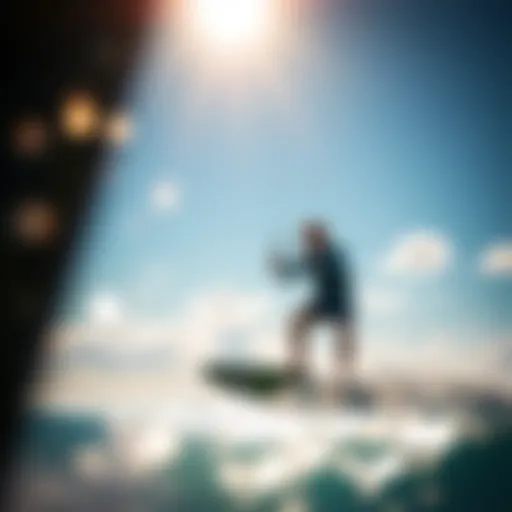Oahu Wind Forecast: Essential Insights for Kiteboarders
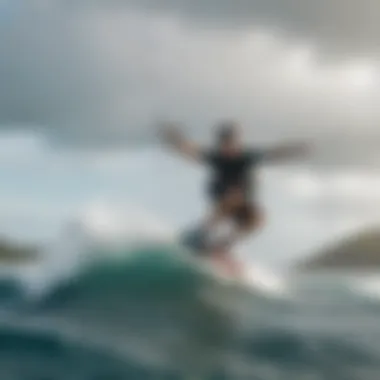

Intro
Oahu, with its breathtaking coastlines and gusting trade winds, offers kiteboarders an exhilarating playground. Understanding the wind forecast here is not just a matter of checking a weather app; it involves navigating a complex web of factors that influence wind patterns. From the rhythms of the seasons to the geographical intricacies that create localized conditions, mastering the intricacies of the Oahu wind forecast requires both knowledge and skill.
This guide aims to provide kiteboarding enthusiasts, be they beginners or seasoned professionals, with the insights needed to interpret wind forecasts effectively. It will take a closer look at how to adapt to real-time changes and leverage available wind data for maximum enjoyment out on the water. Whether you're planning your next ride or analyzing the best conditions for jumps and tricks, understanding the nuances of the wind is crucial for both safety and performance.
Let’s first dive into essential equipment insights, as the right gear will play a vital role in how you respond to changing winds.
Intro to Oahu's Wind Conditions
When it comes to kiteboarding in Oahu, the wind is akin to the lifeblood of the sport. Understanding the local wind conditions is crucial for both safety and enjoyment. The winds can exist in constant flux, influenced by a variety of natural factors, from geography to weather patterns. Knowing this, kiteboarders can fine-tune their skills and better anticipate the breezy mood of the day. The intricate dance between the wind and the water creates a thrilling environment, making knowledge about wind conditions not just beneficial, but essential.
Importance of Wind in Kiteboarding
You might be wondering why wind is so pivotal for kiteboarding. Simply put, wind power propels riders across the water, allowing for exhilarating jumps and tricks. Different winds offer varied experiences, whether you are gliding calmly or tearing through the waves.
- Proper wind conditions contribute significantly to safety.
- Insufficient or overly strong winds may lead to accidents, such as crashing or not being able to launch safely.
- Understanding wind forecasts helps kiteboarders adapt their techniques and equipment to suit varying conditions, maximizing their time on the water.
Riding on the right wind can transform an ordinary day into a memorable adventure. A gentle breeze might be perfect for beginners, while seasoned riders may seek out stronger gusts to push their limits.
Overview of Oahu's Geography
Oahu's unique landscape plays a big role in its wind patterns. The island features coastal shores, mountains, and valleys, each impacting the movement of air. The North and South shores are especially significant due to their reliance on trade winds, which predominantly blow from the northeast.
Here are a few geographical features to keep in mind:
- Koʻolau Range: This mountain range affects wind flow, creating localized changes that can lead to suddenly shifting gusts.
- Kailua Bay: This bay is often another hotspot for kiteboarding, where sea breezes can create favorable conditions.
- Leeward vs. Windward: The distinction between these sides of the island is important for kiteboarders; the windward side typically experiences stronger and more consistent winds.
This diverse geography means kiteboarders must stay sharp and observant, ready to adapt to the constant changes. Just like a surfer reads the waves, a kiteboarder must read the winds.
Meteorological Fundamentals of Wind
Understanding the fundamental meteorological principles behind wind is crucial for kiteboarders navigating the diverse conditions of Oahu. Wind is not just a factor in kiteboarding; it’s the lifeblood of the sport. The behavior of the wind directly influences the kite's performance, the comfort level of the rider, and most importantly, safety while out at sea. As a kiteboarder, grasping the nuances of wind formation and the variables that influence patterns empowers you to make informed decisions on when and where to ride.
Understanding Wind Formation
Wind is essentially the movement of air from one region to another, driven primarily by differences in atmospheric pressure. These pressure differences usually arise due to the uneven heating of the Earth’s surface by the sun. In Oahu, the tropical climate adds complexity to this phenomenon, which kiteboarders need to factor into their plans.
For instance, as the sun heats the land, the air above it becomes warmer and rises. In contrast, cooler air moves in to replace it, leading to what we know as surface winds. There’s a bit more to it than that though.
In Oahu, trade winds are predominant. They generally blow from the east and can vary in strength. This makes mornings a good time for kiteboarding, as winds tend to be consistent and favorable. But, these trade winds can also be influenced by local weather systems, like tropical storms or cold fronts, which can lead to sudden changes. Recognizing these patterns can transform casual riders into skilled navigators.
Factors Influencing Wind Patterns
Several factors come together to shape wind patterns on Oahu. Here are the primary influencers to keep an eye on:
- Topography: The island's mountainous terrain can disrupt the flow of wind, creating pockets of unpredictable conditions. For example, the Koolau Range can channel winds in one direction while blocking them in another.
- Temperature Variations: As previously noted, temperature differences between land and water create contrasting pressure zones. The ocean cools down faster at night, leading to off-shore breezes. This pattern can change dramatically with the advancing day.
- Seasonal Changes: Oahu experiences variations in wind patterns depending on the season. Trade winds strengthen during the summer months, providing great opportunities for kiteboarding, while winter months may bring calmer conditions. Understanding these seasonal trends is essential for planning your kiteboarding excursions.
The better you understand the language of the wind, the more effectively you'll be able to dance with it on the water.
Keeping tabs on these factors not only assists in better taking advantage of favorable conditions but also aids in recognizing when to stay ashore for safety. A strong grasp of these fundamentals is the foundation upon which kiteboarding skills can be built.
Analyzing Oahu's Wind Forecast
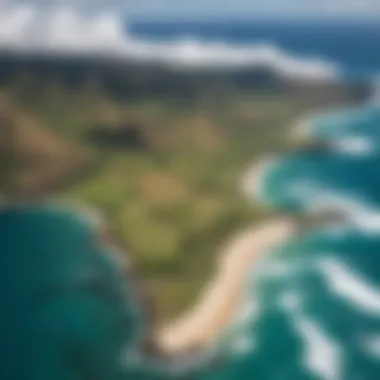

Understanding how to analyze Oahu's wind forecast is crucial for anyone looking to enhance their kiteboarding experience. Kiteboarders benefit immensely from being able to interpret the nuances of wind conditions as generated by both local and regional factors. This section sheds light on various tools and methodologies that assist in mastering Oahu's wind data, which can often be eccentric and unpredictable.
Key Forecasting Tools
Utilizing the right tools for forecasting wind patterns can make all the difference for kiteboarders. Here are some notable resources:
- Windy: This sophisticated app provides an intuitive interface that displays wind speed and gusts in real-time. Users can see overlays of specific locations on the island, offering invaluable insights.
- National Weather Service (NWS): The NWS produces official forecasts that include wind advisories, which can be essential during stormy seasons.
- Kiteboarding Community Websites: Platforms like reddit.com have sections dedicated to wind updates and local tips shared by seasoned kiteboarders.
- Twitter Updates: Following local kiteboarding figures or weather forecasters can provide timely information that may not be reflected in static forecasts.
The use of these tools can improve decision-making significantly, enabling kiteboarders to choose the best times to hit the water.
Reading Wind Graphs and Data
Once you have access to wind forecasts, it’s important to know how to decipher the provided data. Wind graphs can contain a fair bit of information, and understanding them requires a bit of practice. Here are some key pointers to keep in mind:
- Wind Speed and Direction: Charts often plot wind speed on one axis and direction on another. Look for arrows that indicate how fiercely the wind is blowing and from where.
- Gusts: Pay attention to gusts shown as spikes on the graph. These can signal sudden changes that you must adapt to while riding.
- Time Frames: Be mindful of the time intervals represented. Wind conditions can shift quickly, particularly with the interplay of local topography and weather patterns.
"Being able to interpret wind data not only keeps you safe but improves your overall ride."
To truly grasp what the forecasts are telling you, it's recommended to practice reading these graphs before heading out. The more familiar you become with interpreting the details, the better prepared you’ll be for whatever nature throws your way.
Seasonal Wind Trends on Oahu
Understanding seasonal wind trends is crucial for kiteboarders seeking to make the most of Oahu’s conditions. Each season brings its own distinct wind patterns that can drastically affect the kiteboarding experience. Not only does this knowledge enhance riding opportunities, but it also plays an essential role in safety and efficiency on the water.
Kiteboarders can maximize their time and enjoyment through insight into the shifting winds. In Oahu, the seasonal winds can be characterized broadly into winter and summer patterns. By learning these trends, kiteboarders can plan their sessions accordingly—ensuring they hit the water when the winds are just right.
Winter vs. Summer Winds
The winds on Oahu exhibit a clear seasonal shift between winter and summer. During the winter months, typically from November through March, the trades are often more consistent and stronger. This is the time when kiteboarders can expect sustained winds ranging from 15 to 25 knots. The higher pressure systems that dominate the Pacific during winter months tend to keep more stable wind conditions.
In contrast, summer months bring a different tale. Winds can be a bit fickle from May to September, often showing up with less consistency. Summer trades might fluctuate significantly from light to moderate breezes, sometimes dipping below 10 knots. In addition to that, with the warm weather, local thermal winds can create gusty and erratic conditions, especially in zones with buildings or vegetation that disturb airflow. It’s not uncommon to find kiteboarders waiting for winds to pick back up or moving to different spots to find better conditions.
Tip: Always check local forecasts, as summer breezes can pick up in the afternoons, often providing the ideal riding conditions for those willing to wait.
Intermittent Weather Patterns
Weather patterns can influence winds, creating variability in kiteboarding conditions. Oahu’s wind can become quite unpredictable due to local phenomena. Events such as cold fronts, tropical storms, or even passing weather systems can drastically change the expected conditions, making it vital for kiteboarders to stay informed.
Winds can shift quickly during these intermittent events. For example, a passing rain shower may momentarily drop the wind speed, only for a beautiful clearing to bring back stronger gusts.
Moreover, it’s important to note local microclimates. For instance, places like Kailua and Lanikai may experience different wind conditions than those found in Makapu’u or the North Shore, based on their geographic features. This absence of predictability necessitates that kiteboarders be adaptable; knowing how to read the changes in sky and wind patterns will separate the novices from the proficient riders.
In summary, seasonal trends are not just patterns, but crucial elements for kiteboarders looking to navigate Oahu's waters effectively. Understanding these nuances can not only transform your time spent on the water but also assure a safer kiteboarding adventure.
Microclimates and Local Conditions
Understanding the intricacies of microclimates and local conditions is like unlocking the secret recipe to a successful kiteboarding experience in Oahu. While the island is blessed with generally favorable winds, local features can dramatically change how those winds manifest in different spots. Kiteboarders need to grasp these subtleties to make informed decisions about when and where to hit the water.
Coastal vs. Inland Winds
Coastal winds and inland winds often display stark differences. Coastal winds, typically influenced by the ocean's surface, are generally steadier and more consistent. As a kiteboarder, you might find these winds more forgiving, allowing for smoother rides and long sessions. The trade winds coming from the northeast are a prime example. They tend to provide a reliable source of wind along Oahu’s coastline, creating excellent conditions for novice and experienced kiteboarders alike.
On the flip side, inland areas can present a real mixed bag. As the winds move inland, they encounter various obstacles, such as buildings, trees, and hills. These elements can create turbulence and variable wind patterns, making conditions unpredictable. While some skilled kiteboarders relish the challenge, others might consider these areas better suited for land-based activities rather than water sports. In short, know your spots and the typical wind behavior you'll encounter there.
Influence of Topography
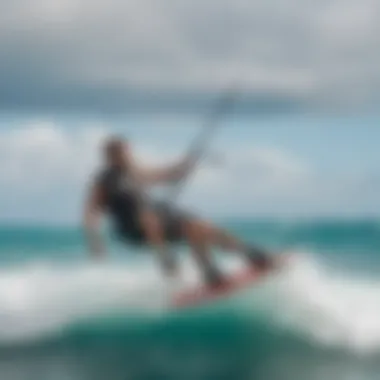

Topography plays a significant role in shaping the wind conditions experienced by kiteboarders in Oahu. The island is a patchwork of valleys, mountains, and coastal features. This diverse landscape can create areas of wind acceleration and deceleration. For instance, as airflow encounters a mountain range, it often gets funneled through valleys, increasing wind speed significantly in those areas. Conversely, wind might calm as it moves into more sheltered locations, such as behind hills or structures.
Additionally, the altitude of certain locations can change the way the wind feels. Higher elevations will often feature stronger gusts, but kiteboarders should consider the challenges of managing a kite in such conditions.
When planning your ride, take a moment to analyze the topographical features of your chosen spot. You might want to keep an eye on nearby hills or ridges that can affect the wind flow. Even minor changes in elevation can lead to different kiteboarding experiences.
Remember that every session is unique. Arm yourself with knowledge about local microclimates and the influences of the landscape to make the most of your time on the water.
In essence, grasping the dynamics of coastal versus inland winds and the influence of topography is vital for kiteboarding success in Oahu. Embrace the local knowledge, consult wind forecasts, and pay attention to the unique features of the terrain around you. By doing so, you can set yourself up for optimal kiteboarding experiences, maximizing both enjoyment and safety on the water.
Kiteboarding Techniques Relating to Wind
Kiteboarding is not just a sport; it’s a dance with nature, where wind plays the lead role. Mastering kiteboarding techniques related to wind can make the difference between a thrilling ride and a challenging experience. Understanding how to harness the winds of Oahu is essential for kiteboarders of all skill levels. The right techniques can enhance performance, improve safety, and ensure you get the best out of every session on the water.
Choosing the Right Gear
When it comes to kiteboarding, having the right gear can become your best friend against an unpredictable wind. The first step lies in selecting a kite that fits the wind conditions. If you're heading out on a breezy day, a smaller kite might do the trick, while lighter winds often call for larger kites. Below are considerations for gear selection:
- Kite Size: Wind range varies based on the size of the kite. Understanding how kite size correlates with wind intensity lets you make informed decisions.
- Board Type: Different boards react uniquely to wind conditions. A twin-tip board offers great versatility, while a directional board shines in certain wave conditions.
- Harness: Comfort is key. The right harness can keep you stable, and reduce fatigue, allowing longer rides without so much strain.
- Safety Equipment: Replicating safety with gear like quick-release systems and impact vests ensures a good time stays safe.
Every kiteboarder needs to remember that gear is not a uniform choice but must be considered with respect to wind conditions.
Adapting to Wind Changes
Wind is infamous for its unpredictability, and being able to adapt quickly can be crucial. Kiteboarders may find themselves in shifting conditions, forcing immediate adjustments. Here are some effective strategies:
- Body Positioning: The stance on the board greatly affects how you catch the wind. A balanced position helps in harnessing the wind effectively, while a forward position can boost speed in stronger gusts.
- Trimming Your Kite: Adjusting your kite’s trim based on wind conditions can enhance performance. Pulling on the trim line can help the kite fly more efficiently in high winds.
- Timing of Turns: Anticipate how the wind shifts during maneuvers. Timing your turns to coincide with wind changes can maintain control and allow for smoother transitions.
- Communication with Your Crew: In a group setting, communicating any perceived wind shifts can immensely help in collectively adapting to changes.
"Real mastery in kiteboarding comes through the understanding of how to dance with the wind rather than fight against it."
This concise understanding emphasizes that kiteboarding techniques oriented around wind can enhance not only the skill but also the overall enjoyment of the sport. Making these techniques a part of your routine helps in riding the winds of Oahu with confidence and prowess.
Safety Considerations in Wind Forecasts
When kiteboarding on the stunning shores of Oahu, the thrill of gliding over turquoise waters and harnessing strong winds is unmatched. Yet, with that exhilaration comes a responsibility — ensuring safety while navigating unpredictable wind patterns. The nuances in wind forecasting are critical for kiteboarders, guiding them in recognizing potentially hazardous conditions and implementing effective safety protocols.
Being aware of the dangers that can arise from adverse wind conditions is paramount for kiteboarding enthusiasts, both experienced and beginners alike.
Recognizing Hazardous Conditions
Hazardous conditions can sneak up on the best of us, and understanding how to spot these dangers can make the difference between a safe outing and a dangerous situation. Kiteboarders must always stay vigilant, as winds in Oahu can shift with little warning due to local topography and seasonal changes.
Here are some key indicators to watch for:
- Sudden Wind Changes: An abrupt increase or decrease in wind speed can signal an approaching storm or turbulent weather. Keep an eye on your surroundings; if the trees are swaying more than normal, it might be time to retreat.
- Darkening Skies: Changes in light can alert you to oncoming weather. Dark clouds often mean rain and wind shifts. Don't be fooled by clear skies early in the day; keep track of weather reports.
- Rough Water Conditions: High waves and choppy waters can indicate that wind conditions are deteriorating. If you notice more whitecaps than usual, consider it a warning.
- Increased Traffic from Other Water Sports: If you see more surfers or boats heading ashore, they might be reacting to changing weather conditions. This could be your cue to follow suit.
As a kiteboarder, your senses should be finely tuned. This mindfulness not only enhances individual safety but also fosters a culture of awareness among fellow riders.
Implementing Safety Protocols
Once hazardous conditions are recognized, it’s crucial to have a solid set of safety protocols in place. These protocols serve as a kiteboarder's safety net, enabling them to navigate through changing conditions with confidence.
- Always Check Forecasts Before You Go: Start your day by reviewing trusted sources for wind and weather updates. Apps and websites like Windy or NOAA can provide live updates.
- Set a Safe Boundary: Determine how far from shore you’re willing to venture based on wind conditions and your skill level. Visibility can change quickly, so be cautious.
- Buddy System: Kiteboarding in pairs can greatly enhance safety. Having a buddy helps keep an eye on each other, especially when conditions shift unexpectedly.
- Emergency Procedures: Know how to perform self-rescue techniques, and have a plan in place for emergencies. Familiarize yourself with your gear to ensure a quick response when needed.
- Wear Safety Gear: Equip yourself with a helmet and impact vest. It’s a small price to pay for added security.
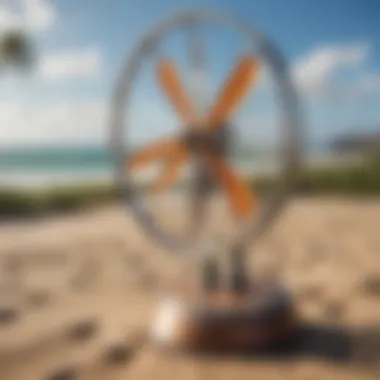

By being proactive and following these protocols, you can significantly reduce risks and enjoy the stunning winds of Oahu. Emphasizing safety is no mere suggestion; it's essential for a fulfilling kiteboarding experience that keeps the excitement alive without compromising well-being.
Ongoing Developments in Wind Forecasting
Staying ahead in the kiteboarding game isn't just about picking the right spot or gear; it also hinges heavily on understanding the evolving landscape of wind forecasting. With the rapid advancements in technology and methodology, kiteboarders can access more precise, timely, and user-friendly information regarding wind conditions. This evolution isn't just a step forward; it’s a game-changer, enhancing both the safety and enjoyment of kiteboarders navigating Oahu's winds.
Advancements in Technology
In recent years, technological breakthroughs in meteorology have transformed how we anticipate wind patterns. Here are some noteworthy advancements:
- High-Resolution Models: Traditional forecasting methods often relied on broader regional data. However, the introduction of high-resolution models allows for localized predictions that take into account terrain and microclimates, crucial for the diverse landscape of Oahu.
- Real-Time Data Access: Kiteboarders can now access real-time data through various apps and websites. This means that kiteboarders are no longer left to guess wind strength or direction from outdated information.
- Doppler Radar Systems: These systems provide minute-by-minute updates of wind movements, allowing for more accurate forecasting and the ability to respond to sudden weather changes.
The shift is undeniable; these advancements empower kiteboarders to make informed decisions, increasing time spent on the water and reducing risks associated with unpredictable wind conditions.
Future Predictions for Kiteboarding
As wind forecasting continues to evolve, it’s worth considering what the future holds for kiteboarding specifically. With the blend of evolving technologies and innovative practices, here are some fascinating predictions:
- AI-Powered Forecasting: Artificial Intelligence is set to transform forecasts, analyzing historical data and current conditions to make nearly predictive models that account for even the most subtle variations in weather patterns. Imagine algorithms fine-tuning predictions based on local wind anomalies—this isn't science fiction; it's on the horizon.
- Wearable Technology: The incorporation of wearables that can monitor real-time environmental conditions such as wind speed and direction is likely. This means a kiteboarder could get immediate updates and alerts right on their wrist while out on the water.
- Collaborative Forecasting: As community forums like those on Reddit grow, kiteboarders can share local observations that might inform broader forecasts, making the entire forecasting process a community-driven endeavor.
The future of kiteboarding forecasting looks promising. As technology grows and changes, so too will the opportunities for kiteboarders to enjoy optimal conditions while maximizing their safety and skills impacting their entire experience.
Resources for Kiteboarders
In the realm of kiteboarding, knowledge is power. Having access to the right resources can significantly enhance your on-water experience, from planning to execution. In Oahu, where the winds can play tricks on even the most seasoned of kiteboarders, understanding where to find quality information is paramount. This section unveils vital resources that equip kiteboarders with the tools they need to navigate wind forecasts and improve their skills.
Useful Websites and Applications
The internet is a treasure trove of information, especially for kiteboarders eager to keep up with changing wind conditions. Here are some essential websites and apps to keep at your fingertips:
- Wind Guru: This site offers detailed forecasts, wind maps, and real-time data specific to Oahu. Its user-friendly interface allows easy access to information.
- Kiteboarding.com: A one-stop-shop for kiteboarding enthusiasts. It hosts an array of resources including articles, gear reviews, and expert tips.
- iKitesurf: An app and website that provides precise wind measurements and weather alerts tailored for kiteboarders.
- Windfinder: Known for its reliable wind forecasts, it includes specialized forecasts for popular kiteboarding spots around Oahu.
These platforms are incredibly useful for tracking wind data, learning about local spots, and even connecting with local pros who can provide insider techniques and tips.
Community Forums and Support Groups
Finding a community of likeminded individuals can vastly enhance your kiteboarding journey. Engaging in forums and support groups provides kiteboarders with the opportunity to share experiences and ask questions. Here are some recommended resources:
- Reddit’s Kiteboarding Community: This platform brings together enthusiasts from around the globe. You can find advice, local spot recommendations, and gear discussions.
- Facebook Groups: Search for local kiteboarding groups specific to Oahu. These groups often provide real-time updates about wind conditions and organize meet-ups for fellow enthusiasts.
- Meetup.com: This site is useful for connecting with local kiteboarders and joining groups focused on kiteboarding activities and events.
By diving into these communities, kiteboarders can share knowledge, foster friendships, and support one another in navigating the sometimes unpredictable winds of Oahu.
Remember, the kiteboarding community in Oahu is welcoming. Don't hesitate to reach out—many seasoned kiteboarders are eager to help newcomers navigate the winds.
Culmination: Enhancing Your Kiteboarding Experience
As we wrap up the exploration of Oahu's wind forecast, it's vital to recognize how these insights can significantly uplift your kiteboarding journeys. The dance between the wind and water becomes not just a recreational activity but a finely tuned sport when one understands the nuances of wind patterns. Wind is the lifeblood of kiteboarding; knowing it intimately is like having a secret weapon against the whims of nature.
Integrating Wind Knowledge
Integrating wind knowledge into your kiteboarding routine is not merely about following the numbers on a chart or a fancy app; it’s about developing an intuitive feel for how conditions change. Here’s how you can better integrate this understanding:
- Study Wind Trends: Take time to observe how different locations on Oahu react under varying conditions. Each spot has its personality when it comes to wind, ranging from the constant breezes at Kailua Beach to the unpredictable gusts at Makaha.
- Keep a Log: Maintaining a kiteboarding journal helps track how different wind conditions affect your rides. Note the time, place, and conditions, with specific focus on the wind speed and direction. This becomes your personal guidebook of insights.
- Participate in Local Discussions: Engage actively in community forums and discussions. Sometimes you can learn more from seasoned kiteboarders through conversations than any guidebook can teach. Sharing stories and tips regarding the wind can help everyone sharpen their skills. Reddit’s kiteboarding subreddits can be great platforms for this.
By embedding these practices into your routine, you'll not just ride the waves; you'll dance with them harmoniously.
Invitation to Explore Oahu's Winds
Oahu’s winds offer an open invitation to adventures that are waiting to unfold. Each wind condition presents a unique opportunity for kiteboarders, whether you're a novice or a seasoned pro. Take the excitement of exploration seriously:
- Try Different Spots: Oahu is rich with diverse kiteboarding locales. Each offers its own charm and challenges. Exploring spots like Lanikai or the northern shores could transform your understanding of wind behavior.
- Join Local Events: Participating in local kiteboarding events not only sharpens your skills but connects you with the community. Events often bring together a mix of different skill levels and knowledge, giving you the chance to learn from a wide range of experiences.
- Embrace the Unknown: Sometimes the best experiences come from spontaneity. Venture out during off-peak winds and experiment with your gear. Each ride in unfamiliar conditions can potentially teach you something fresh, pushing your limits and expanding your skill.





